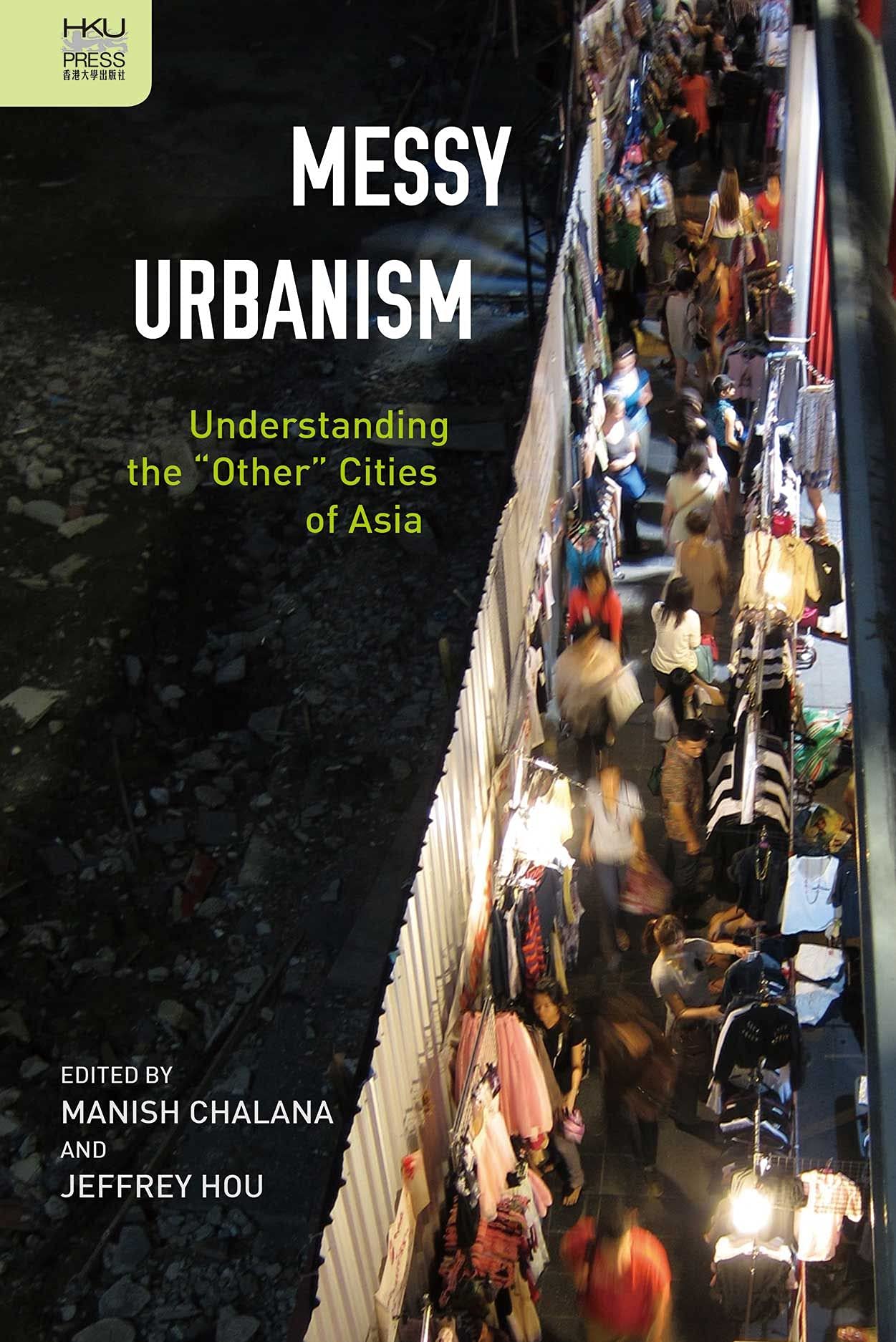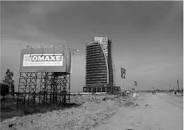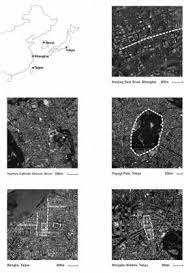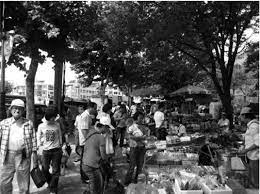Manish Chalana and Jeffrey Hou
Hong Kong University Press

Messy urbanism is almost alright. This is perhaps the unwritten dictum of Messy Urbanism: Understanding the “Other” Cities of Asia, in which fourteen writers explore a dynamic and an emergent urban phenomenon. The book argues that Asian cities from Delhi to Tokyo attenuate an existing system in which order is not so much abandoned as scavenged, refracted, or mutated. There is a tenuous truce between what is claimed as the necessary order of things, predicated on cities’ strategic plans, and the simultaneous promotion of contrary or divergent tactics. Occupy Wall Street and Arab Spring, even Black Lives Matter riots on American streets, all demonstrate inequities and pathologies lurking within the “system.” The nineteenth-century European city is the classic urban mess that needed to be cleared, cleaned up with public spaces and social policies in housing, education, and health. But then there are other messes—the messes in this book—which call for a reverse action: planners, policy makers, and architects ought to embrace the life-world practices that arrive as unforeseen forces and unpredicted events, rich with new possibilities. José Edgardo A. Gomez Jr. writes that there is indeed a differential mess within all Southeast Asian cities—“a recurrent, if inelegant logic” (77)—and that is perhaps the takeaway of this book.
In short, Messy Urbanism posits the city as an oscillation between two destinies. Editors Manish Chalana and Jeffrey Hou begin by describing a scene from Wong Kar Wai’s film Chungking Express, set in the notorious chaos of Honk Kong’s Chunking Mansions, inviting us to the abyss, so to speak, and challenging us to see what constitutes the production of such concatenated conditions. In discussing Tokyo, Ken Tadashi Oshima points out that messy has many meanings, which hints that each city is fabricated in the language of its place (103). Such linguistic notions as informality, impromptuness, inclusivity, and insurgency that characterize the messy city need to be assessed in the framework and nuances of local languages.

There are therefore as many messinesses as there are cities. We learn that Shinjuku is polyphonic rather than messy. Koompong Noobanjong writes that Bangkok’s Royal Field is a “polysemic urban palimpsest” (83), like the Indian maidan. Annette M. Kim argues that the “desire to control” the sidewalks of Ho Chi Minh City is a critical emblem of messy urbanism (25). Jose Edgardo A. Gomez, Jr. claims that the “syncopations” (77) of Manila have a pattern distinct from Chinese, Indian, and Western notions of order-making. Hou and Chalana assert that in Taipei’s Shilin, as in Bangkok’s Siam Square (3-4), urban life entertains two fluctuating rhythms: “order/disorder, formal/informal, legal/illegal” (3).

It is understandable that a modest book (252 pages) cannot take on the full panoply of Asian cities. Nevertheless, Western Asia, from Kabul to Aleppo and Beirut, where convulsed cities have become a norm, begs for a distinctive reading of messy urbanism. Also missing are Dhaka, where the transgression of gender boundaries within the messy garment factories has upended civic corridors, and Karachi, where ethnic factions have created miniature cities within the city. There is a necessity to apply the parameters raised in this book to small or midrange towns that are overlooked in the study of Asian cities. Is messy urbanism a megalopolitan phenomenon, the inability of the megacity to come to terms with the burgeoning frontiers of its own making?
The “other” of the subtitle is the least explored topic in the book. Daisy Tam’s analysis of Little Manila in Honk Kong looks at the othering of Filipino workers. But the unexplored other in this case is in the context of the reception of Asian cities in global discourse, whether it is a World Bank argument to better what it assesses as a debilitating condition, or a New York Times article shining light on what its correspondent deems to be a dark aspect, or a Hollywood film celebrating the underdog life, as in City of Joy or Slumdog Millionaire. Indian cities especially seem to be natural sites of the urban “other.” Istanbul, too, serves merely as an exotic film location, perfect for motorbike chases on the roofs of old buildings or through the crowded souks.

The book would have benefited from some introspection into one’s complicity in participating in the dominant order and entering the circle of mess. As Abidin Kusno writes, messiness is a perception as well as a product of knowledge (41). Who will identify and write about the mess? Is there a conundrum about self-representation here, akin to the lack of voice for the subaltern to speak? Those who live within the mess and navigate its channels, like fish in water, do not theorize about it. Is then the theorizing of messiness a prerogative of those who are outside the fish tank, so to speak, or sitting on its rim, one leg in the water?
If the modernist city—the antagonist in this narrative—has arrived in Asia, it is in bits and pieces, contentiously and reluctantly, and in the historic horizon of each city. Messy urbanism in Asia is the failure of the modernist city to find a home; in that sense, the city is perpetually under construction. Messy urbanism is Asia’s aspiration for the contours of a new city that is inclusive and evolutionary, although each city is evolving according to its own trajectory. Whether it is Neo-Tokyo in the manga-inspired film Akira (1988), or whether the mess is a post-apocalyptic nightmare or a bundle of atomic fire, there is still redemption and reconciliation. In three separate movies, the monster Godzilla arrives to terrorize Tokyo and destroy Shinjuku. In 2015, the Shinjuku Ward awarded residency to Godzilla and made him a special ambassador for tourism. No matter how big the mess is, or in whatever form it comes, there is hope after all.
Kazi K. Ashraf is an architect and architectural historian, trained at MIT and the University of Pennsylvania. Having taught at the University of Pennsylvania, University of Hawaii, Temple University, and Pratt Institute in the US, he currently heads the Bengal Institute for Architecture, Landscapes and Settlements in Dhaka, Bangladesh. His publications include Locations: Anthology of Architecture and Urbanism, Volume 1 (Oro 2017), The Hermit’s Hut: Architecture and Asceticism in India (University of Hawaii Press 2013), and Designing Dhaka: A Manifesto for a Better City (Loka Press 2012).
How to Cite This: Ashraf, Kazi K. Review of Messy Urbanism: Understanding the “Other” Cities of Asia, by Manish Chalana and Jeffrey Hou, JAE Online, June 18, 2021.






